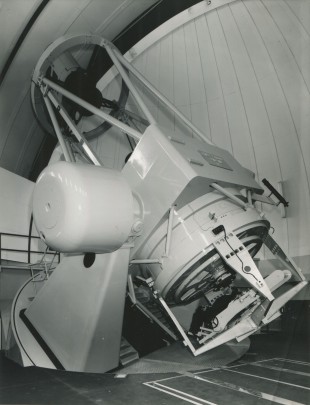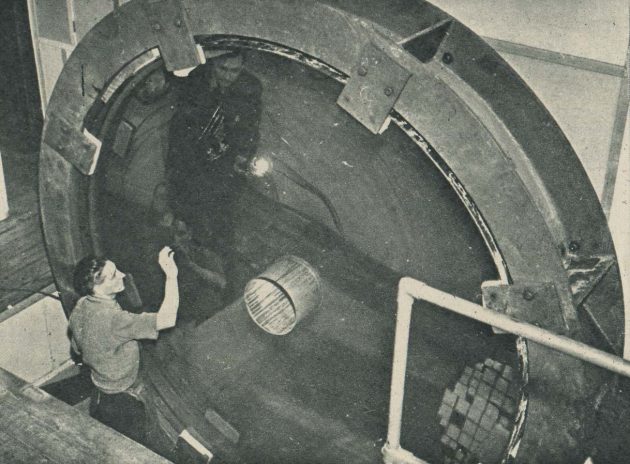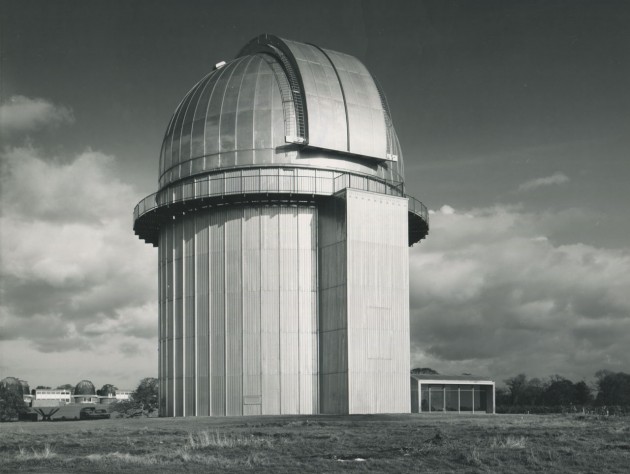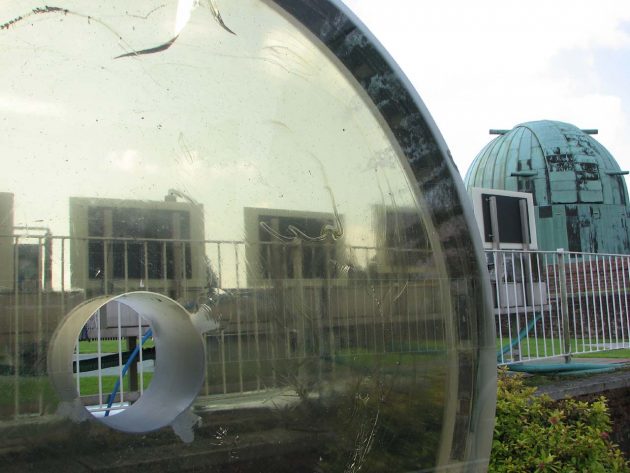…where east meets west
- Home
- Brief History
- The Greenwich Meridian
- Greenwich
(1675–1958) - Herstmonceux
(1948–1990) - Cambridge
(1990–1998) - Outstations (1822–1971)…
- – Chingford (1822–1924)
- – Deal
(1864–1927) - – Abinger
(1923–1957) - – Bristol & Bradford on Avon
(1939–1948) - – Bath
(1939–1949) - – Hartland
(1955–1967) - – Cape of Good Hope
(1959–1971)
- Administration…
- – Funding
- – Governance
- – Inventories
- – Pay
- – Regulations
- – Royal Warrants
- Contemporary Accounts
- People
- Publications
- Science
- Technology
- Telescopes
- Chronometers
- Clocks & Time
- Board of Longitude
- Libraries & Archives
- Visit
- Search
Telescope: Isaac Newton Telescope (1967/1984)

The Isaac Newton Telescope, November 1967. Ministry of Works photo G12042/1, Humphry Smith Photographic Archive
For most people, the name of Isaac Newton conjures up visions of a great scientist. For the Royal Observatory, the name has often been associated with trouble. So it was when Flamsteed fell foul of Newton in the early days of the Observatory, and so it was again, when the tercentenary of his birth came to be celebrated in the 1940s. The legacy of those celebrations was the 98-inch Isaac Newton Telescope (INT).
Other things being equal, the tercentenary celebrations should have taken place in 1942. The war caused their postponement and they eventually commenced on 15 July 1946. At the end of the war, a proposal emerged via both the Royal Society and the Royal Astronomical Society for a large reflecting telescope for the use of all British Astronomers. A suggestion that the proposal should be linked with the forthcoming tercentenary celebrations of Newton – the man who had built the first reflecting telescope – fell on receptive ears. On the first day of the celebrations, it was announced that the Chancellor of the Exchequer had agreed to ask Parliament to vote funds for an observatory with a 100-inch telescope to be known as the Isaac Newton Telescope.
An independent Management Board was set up. Chaired by the Astronomer Royal, it met for the first time in July 1947. The site chosen for the telescope was the Royal Observatory at Herstmonceux – it had after all only recently been chosen as the best available site in England for the Royal Observatory itself, and half the funding was in any case to come from the Admiralty. In 1949, a gift of a 98-inch mirror blank that had been cast in 1936 was received from the Trustees of the McGregor Fund in America. It arrived at the Surrey Docks on 8 August that year and was transported to the Observatory’s Greenwich site where it was unloaded.

The 98-inch mirror blank undergoing inspection at the Grubb Parsons works in 1951. Note the figure standing behind the disc as well as the reflection of the person who is touching it from the front. From an unidentified news article
Progress on the project was slow, and faltering – partly because the promised funding was only released in tiny dribs and drabs, and partly because the telescope was being designed by committee without a properly designated project leader.
When Spencer Jones retired at the end of 1955, little real progress had been made. One of the first acts of his successor Woolley was to simplify the design. By the summer of 1966 – a further ten years having passed – the fabrication of the telescope by Grubb Parsons in Newcastle was virtually complete, the hemispherical framework for the dome was in place and the drum partially clad. The telescope was inaugurated by HM The Queen on 1 December 1967.

The newly completed Isaac Newton Dome from the south, with the Equatorial Group behind and to the left. Today, the dome is largely hidden from view by the trees that were planted in 1962/3. Ministry of Public Building and Works photograph No. G12042/8, November 1967
In all, the telescope had taken over 20 years to build – and during those years, the number of universities in Britain had doubled and travelling to overseas destinations had become both cheaper and subject to fewer bureaucratic restrictions. From the early days, there had been ongoing criticism of the project, with many believing that the telescope should never have been sited at Herstmonceux, but at a better location overseas. In the end, these critics got their way following the appointment of Margaret Burbage as the Observatory's new Director in 1972. The observing programme with the INT at Herstmonceux ceased in 1979 and the telescope was re-located (in modified form and with a new mirror) to La Palma in the Canary Islands.
The Isaac Newton Group of Telescopes (ING official site)
In view of the fact that there are several published accounts of the history of the telescope (listed below), it is not planned to give a detailed history here.
Specification at time of opening in 1967
| Mirror material | Aluminised pyrex glass | |
| Mirror weight | 9,000lb (4,082Kg) | |
| Mirror aperture | 98.2im (2.5m) | |
| Mirror thickness | 16.1in (41cm) | |
| Mriror surface | Parabaloid | |
| Prime focus mode | f/3 (observer rides in a capsule at the mouth of the telescope) | |
| Cassegrain focus mode | f/14.1 (observer rides in a chair slung below the mirror) | |
| Coudé focus mode | f/32.3 (observer at a fixed focus one floor below the telescope) | |
| Cost | The Science Research Council put the figure at £956,600 in August 1967 |
The telescope as recorded by British Pathé in 1967
British Pathé made at least four visits to film at Herstmonceux, including one in December 1967 when the Isaac Newton Telescope was filmed around the time of its opening. The footage can be accessed via the link below.
The Isaac Newton telescope. (Running time 1 min 14 sec).
Optical specifications when rebuilt with a new mirror on La Palma
The following specifications are taken from the ING website:
‘The optical system of the INT is a conventional Cassegrain with a paraboloidal primary mirror and a hyperboloidal secondary. The primary has a diameter of 2.54-m (the original 98-inch primary mirror was replaced by a 100-inch mirror when the INT was moved to La Palma) and a focal length of 7.475-m, giving a focal ratio of f/2.94 at the uncorrected primary focus. It weighs 4,361 kg and it is made of Zerodur and has a negligible coefficient of expansion (10-7 K-1 approximately). On axis, 80% of the light from a point image lies within a circle of 0.3 arc sec in diameter. A three-element corrector with a flat rear surface and increased back focal distance, is used at the prime focus to give an unvignetted field of 40 arc min at a scale of 24.68 arc sec/mm. The images are calculated to be smaller than 0.5 arc sec diameter everywhere over the unvignetted field for incident wavelengths in the range 3650 Å to 10140 Å. The two secondary mirrors give f/15 Cassegrain and f/50 Coudé foci (although the latter was never implemented on La Palma). The scale at the Cassegrain focus is 5.41 arc sec/mm and the unvignetted field is 20 arc min.’
The old mirror and dome today
Today, there is no public access to the old dome at Herstmonceux, which stands derelict amongst the trees with just the top visible from the surrounding countryside. The original mirror (now unsilvered) can be seen at The Observatory Science Centre in the Castle grounds.

The 98-inch mirror on display at Herstmonceux. Note the imperfections which are visible within the glass and had to be avoided during the grinding of the surface. Photo September 2008
Further Reading
In their Reports to the Board of Visitors, beginning in 1947 and ending in 1964, the Astronomers Royal normally gave an update on the Telescope (usually towards or at the end). The practice was generally continued in the later Royal Greenwich Observatory Reports. The last of these was published in 1987. Click here to access those Reports which are available online.
The Isaac Newton Telescope. Richard Woolley, QJRSAS, Vol 3, p.249, (March 1962)
The Isaac Newton Telescope. Four page leaflet produced by the Science Research Council to coincide with the opening of the Isaac Newton Telescope (1967)
The Isaac Newton Telescope. Francis Graham Smith & Janet Dudley, Journal for the History of Astronomy, Vol. 13, P. 1, (1982)
The Isaac Newton Telescope (information from ING)
The Isaac Newton Telescope: `First Light' on La Palma. Nigel Henbest, Journal of the British Astronomical Association, vol.94, no.3, p.118–123 (1984)
The Isaac Newton Group. R. Laing & Derek Jones, Vistas in Astronomy, vol. 28, Issue 2, pp.483–503 (1985)
The Isaac Newton Telescope. Bernard Pagel, Quarterly Journal of the Royal Astronomical Society, Vol. 27, No.3 (1986). The Isaac Newton Telescope and its Coudé Spectrograph..R.F. Griffin, Quarterly Journal of the Royal Astronomical Society, Vol.28, No.2 (1987)
The origins and construction of the Isaac Newton Telescope, Herstmonceux, 1944–1967. Lee Macdonald, Journal: Journal of the British Astronomical Association, vol.120, no.2, p.73–86 (2010). Alternative Link
‘A large chunk of glass’: The 98-inch mirror of the Isaac Newton Telescope, 1945–1959. Lee Macdonald, The Antiquarian Astronomer (January 2012)
Paul Murdin interview with Iain Todd for BBC Sky at Night Magazine (December 2017)
© 2014 – 2025 Graham Dolan
Except where indicated, all text and images are the copyright of Graham Dolan